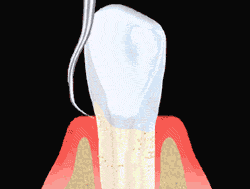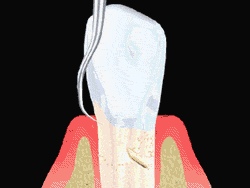Many times, the early stages of periodontal disease are best treated with non-surgical periodontal therapy. Even in severe cases of periodontal disease, non-surgical periodontal therapy often precedes surgical therapy. This is done to improve the overall tissue quality prior to surgery and also to help limit the areas requiring surgery.
Treatment methods depend upon the type of disease and how far the condition has progressed. The first step is usually a thorough cleaning that may include scaling to remove plaque and tartar deposits below the gumline.

Subgingival Scaling: Cleaning the tooth below the gumline

Root Planing: Smoothing the tooth root
The tooth roots may also be planed to smooth the root surface allowing the gum tissue to heal and reattach to the tooth. In some cases, the occlusion (bite) may require adjustment.
Antibiotics or irrigation with anti-microbials (chemical agents or mouth rinses) may be recommended to help control the growth of bacteria that create toxins and cause periodontitis. In some cases, your doctor may place an antibiotic in the periodontal pockets after scaling and root planing. This may be done to control infection and to encourage normal healing.
When deep pockets between teeth and gums are present, it is difficult for your doctor to thoroughly remove plaque and tartar. Patients can seldom, if ever, keep these pockets clean and free of plaque. Scaling and root planning, sometimes called a deep cleaning, may take two to four visits based upon the level of periodontal disease. Thereafter, surgery may be needed to restore periodontal health.
